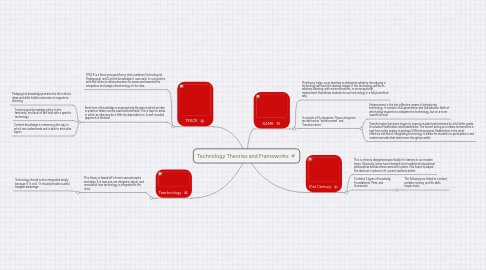
1. SAMR
1.1. This theory helps us as teachers to determine whether introducing a technology will have the desired impact. If the technology will be an arbitrary sidestep, with minimal benefits, or an exceptional replacement that allows students to use technology in a fully beneficial way
1.2. It consists of 2 categories. These categories are defined as "enhancement" and "transformation."
1.2.1. Enhancement is the less effective means of introducing technology. It consists of Augmentation and Substitution. Both of which allow students to integrate the technology, but on a more superficial level
1.2.2. Transformation has been shown to improve student performance by a full letter grade. It includes Modification and Redefinition. The former acting as a means to transform a task from solely analog to perhaps 50% technological. Redefinition is the most effective method of integrating technology. It allows for students to participate in and create new tasks that were never thought possible
2. TPACK
2.1. TPACK is a three-pronged theory that combines Technological, Pedagogical, and Content knowledge. It uses each in conjunction with the others to allow educators to assess and examine the integration and usage of technology in the class.
2.2. Each form of knowledge is assessed and the area in which an idea or practice falters can be examined and fixed. This is true for areas in which an idea may be a little too dependent on. A well rounded approach is the best.
2.2.1. Pedagogical knowledge pertains the the intrinsic ideas and skills held be educators in regards to teaching
2.2.2. Technological knowledge refers to the familiarity, and level of skill held with a specific technology.
2.2.3. Content knowledge is referencing the way in which one understands and is able to articulate topics
3. 21st Century
3.1. This is a theory designated specifically for learners in our modern times. Obviously, times have changed since traditional educational philosophies and doctrines were set in place. This hopes to adjust the ideas set in place to fit current students better
3.2. Contains 3 types of knowledg. Foundational, Meta, and Humanistic
3.2.1. The following are linked to content, problem solving, and life skills respectively
4. Teachnology
4.1. This theory is based off of one's own principles and ideas. It is how one can integrate, adjust, and reestablish how technology is integrated in the class
4.1.1. Technology should not be integrated simply because it "is cool." It should provide a useful, tangible advantage.
